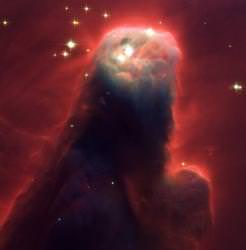

It’s amazing to think that the Sun and planets formed out of a diffuse cloud of gas and dust. Somehow, the dust clung together into larger and larger particles – grains of sand. This sand then went on to become pebbles, rocks, and eventually entire planets. Well now astronomers have discovered a young star system with a disk of sand-sized particles orbiting it.
The discovery was made by Christopher Johns-Krull, assistant professor of physics and astronomy at Rice University, working with collaborators in the US, Germany, and Uzbekistan.
Astronomers have detected microscopic dust particles orbiting other stars before, but only by sensing their infrared emissions. This method isn’t precise enough to tell astronomers how big these particles become, or how far they’re orbiting from the newly forming star.
In this new study, the researchers measured the light reflected from sand orbiting a binary system called KH-15D. The stars are about 2,400 light years from Earth in the Cone nebula, and they’re a mere 3 million years old.
The researchers discovered that the Earth has a nearly edge-on view of KH-15D. From our point of view, the dusty disk mostly blocks the stars from view, but one star has an eccentric orbit that occasionally peeks up above the disk.
“We were attracted to this system because it appears bright and dim at different times, which is odd. These eclipses let us study the system with the star there and with the star effectively not there,” Johns-Krull said. “It’s a very fortuitous arrangement because when the star is there all the time, it’s so bright that we can’t see the sand.”
The team examined 12 years of data gathered by a handful of observatories around the world, and studied how light from the star was being reflected by the disk. They were able to determine the chemical composition and size of the sand-like particles.
Original Source: Rice University News Release
Let’s dive into one of those cosmic curiosities that's bound to blow your mind: how…
The majority of the universe remains unmapped, but we have a potential window into it…
NASA engineers are pressing ahead with preparations for the Artemis II mission unless someone tells…
It’s not uncommon for space missions to be tested here on planet Earth. With the…
Some of our Solar System's moons have become very enticing targets in the search for…
Gateway’s HALO module heads to the U.S., on its long path to orbiting the Moon.…